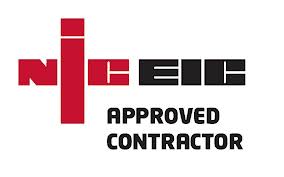AN UNUSUALLY FAIR OFFER TO HELP CHURCHES AND CHURCH SCHOOLS TO STAY SAFE AND LEGAL Introduction You will hopefully be aware that all organisations in the UK are required, under the Electricity at Work Regulations, to maintain their electrical installations in a safe condition. One of the accepted ways to satisfy this requirement is to have Periodic Inspections carried out by an NICEIC Approved Contractor. The problem is that the work undertaken on many Periodic Inspections are governed by price, not safety! When your next Periodic Inspection is due, you may be looking for a new electrical contractor to carry out this task for you. Obviously you don’t want to waste money so you might be comparing prices given by different contractors. However, not all contractors will adhere sufficiently to the regulations and you could be left with a saving in money but at a cost to safety. The Regulations and/or Best Practice Periodic Inspections along with other testing and installation regulations are governed by the UK electrical installation requirements of BS7671 currently the 17th edition. The section of BS7671 that covers Periodic Inspection appears very small but there is a separate publication of over 100 pages, called Guidance Note 3 containing its associated inspection and testing requirements. At the end of a Periodic Inspection an Electrical Installation Condition Report (formerly known as a Periodic Inspection Report) will be provided and will identify a number of key findings. The following classification codes are used; Code 1, identifies situations where there is an immediate danger. Having identified an immediate danger, the contractor is required under the Electricity at Work Regulations to MAKE SAFE. This does not necessarily mean fixing a problem or turning the circuit off until it has been fixed. It has to be made safe for use, depending on the location and the problem. For example, if the problem was a broken socket with access to live parts in a location where children might touch it and get electrocuted, a temporary barrier could be provided to prevent access. Code 2, identifies situations where there is potential danger, such as no earth provision, where under fault conditions a person could be electrocuted. Clearly this needs to be dealt with as soon as possible. Code 3 identifies situations where improvement is recommended under the Regulations. The wiring regulations (BS7671) are not retrospective, so installations are not required to be upgraded to the latest standard purely because there is a more up to date version. However, there may be certain aspects of older installations where a Code 3 would be appropriate. Previous editions of BS 7671 did contain a code 4 but this has now been deleted. The Electrical Installation Condition Report must identify whether the installation is safe for continued use and will list any Code 1, Code 2 or Code 3 deficiencies. It does not specify the remedies to these deficiencies to enable various quotes to be compared and there may be several different ways of overcoming the deficiencies. We would provide a quote for the most suitable remedies in our opinion, having regard to all the circumstances, including the history of the installation and any plans you may have for its future. In order to carry out a Periodic Inspection, certain information and documentation must be available before work begins. Every non-domestic electrical installation creates obligations under Health and Safety at Work legislation, some of which fall under the Construction Design Management Regulations 2007 (CDM), which require the keeping of a Health and Safety File. All safety certificates including those for the Electrical installation should have copies kept in this file. So, the original electrical installation certificate plus any certificates issued for alterations and/or additions since the original installation was fitted, and any Periodic Inspection Reports, should all be in this file. This enables an inspector to see the history of the installation and determine what areas have not previously been tested or highlight data indicating signs of wear or deterioration. There should also be at least a circuit schedule attached to every distribution board identifying what circuits and components are protected by what fuses etc., and ideally there should be schematic drawings of the entire installation, including earthing and bonding. If there is a lightning protection system on the building, surge protection should be considered. If there are lots of electronic devices such as computers or PC’s, high integrity earthing should also be considered. N.B. The Construction Design and Management Regulations 2007 apply to …..any building work and includes …… the installation, commissioning, maintenance, repair or removal of ….. electrical,….. telecommunications, computer or similar services which are normally fixed within or to a structure (ie building). Some common problems Unfortunately the work undertaken for many Periodic Inspections tends to be governed by price not by safety, and inappropriate reliance placed on that part of Guidance Note 3 which states that (in certain circumstances) only 10% of the installation needs to be tested. This is known as a “limitation” because not everything will be tested, and has created a misconception that only 10% testing is acceptable. Sadly, in many instances, this has become common practise in order to secure testing jobs when different contractors are competing on price. A limitation of 10% testing of an installation should only occur if all previous documentation is available and there is no reason to believe damage or wear and tear is excessive. For example, if during a 10% limitation Inspection, defective parts were identified, the sample area should be increased to, perhaps 40%, and if more deficiencies were then identified, it would be unreasonable to expect there to be no more deficiencies in the remaining parts of the installation, so 100% testing should take place. There are some areas such as the mains intake, earthing, bonding and distribution boards & circuits that should always have 100% inspection and testing. If there is a shortage of previous documentation, there can be no justification to rely on limitations, which will obviously result in subsequent Periodic Inspections taking longer and costing more.
In many installations there will have been numerous additions or alterations where little or no consideration has been given to the cumulative loading of the supply cables. If different jobs have been awarded to different contractors with only price in mind, no one is looking at the overall situation.
Our Offer We pride ourselves on doing the job properly, so instead of putting in a comparative quote for the level of work required we are going to let you decide how much to pay and will do the inspection as it should be done. This offer is for the Periodic Inspection only, not for a site survey, fire alarm and emergency lighting inspection or risk assessment and not for Portable Appliance Testing or any remedial work. So, to sum up, for churches and church schools in our area, we would like to offer the opportunity to have a Periodic Inspection (as it should be done) to ensure the installation is safe for continued use. When completed, we will issue the original report to you, and then invite you to pay us what you think is appropriate* for the work we have undertaken. There is no minimum. When you have paid us this sum, and if any installation deficiencies or recommendations have been identified, we will provide to you a separate quotation on a fair and reasonable basis to carry out the work necessary, but you will be under no obligation to use us for that work. *This opportunity will remain open subject to “take up” and for as long as our proposal is treated in the spirit in which it is offered. If you would like to respond positively to this initiative or if you have any questions, please email us at info@230v.biz References References are available if required, for those exploring this opportunity with us. Qualifications The Lead Inspector for this work would be John Stewart. He:-
|
||||
 Surrey Electrical Contractors Ltd
Surrey Electrical Contractors Ltd